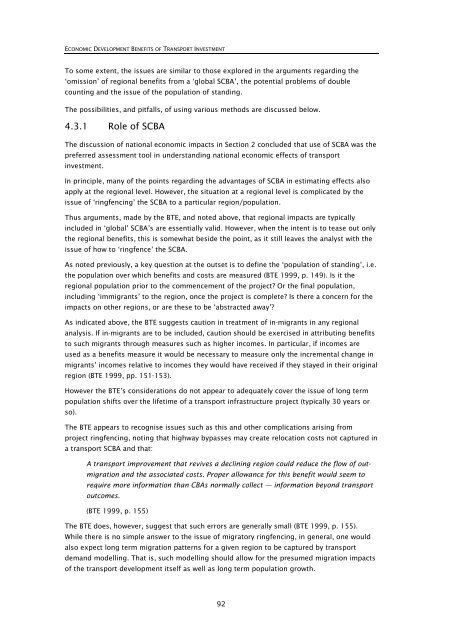Research 350 - NZ Transport Agency
Research 350 - NZ Transport Agency
Research 350 - NZ Transport Agency
You also want an ePaper? Increase the reach of your titles
YUMPU automatically turns print PDFs into web optimized ePapers that Google loves.
ECONOMIC DEVELOPMENT BENEFITS OF TRANSPORT INVESTMENT<br />
To some extent, the issues are similar to those explored in the arguments regarding the<br />
‘omission’ of regional benefits from a ‘global SCBA’, the potential problems of double<br />
counting and the issue of the population of standing.<br />
The possibilities, and pitfalls, of using various methods are discussed below.<br />
4.3.1 Role of SCBA<br />
The discussion of national economic impacts in Section 2 concluded that use of SCBA was the<br />
preferred assessment tool in understanding national economic effects of transport<br />
investment.<br />
In principle, many of the points regarding the advantages of SCBA in estimating effects also<br />
apply at the regional level. However, the situation at a regional level is complicated by the<br />
issue of ‘ringfencing’ the SCBA to a particular region/population.<br />
Thus arguments, made by the BTE, and noted above, that regional impacts are typically<br />
included in ‘global’ SCBA’s are essentially valid. However, when the intent is to tease out only<br />
the regional benefits, this is somewhat beside the point, as it still leaves the analyst with the<br />
issue of how to ‘ringfence’ the SCBA.<br />
As noted previously, a key question at the outset is to define the ‘population of standing’, i.e.<br />
the population over which benefits and costs are measured (BTE 1999, p. 149). Is it the<br />
regional population prior to the commencement of the project? Or the final population,<br />
including ‘immigrants’ to the region, once the project is complete? Is there a concern for the<br />
impacts on other regions, or are these to be ‘abstracted away’?<br />
As indicated above, the BTE suggests caution in treatment of in-migrants in any regional<br />
analysis. If in-migrants are to be included, caution should be exercised in attributing benefits<br />
to such migrants through measures such as higher incomes. In particular, if incomes are<br />
used as a benefits measure it would be necessary to measure only the incremental change in<br />
migrants’ incomes relative to incomes they would have received if they stayed in their original<br />
region (BTE 1999, pp. 151-153).<br />
However the BTE’s considerations do not appear to adequately cover the issue of long term<br />
population shifts over the lifetime of a transport infrastructure project (typically 30 years or<br />
so).<br />
The BTE appears to recognise issues such as this and other complications arising from<br />
project ringfencing, noting that highway bypasses may create relocation costs not captured in<br />
a transport SCBA and that:<br />
A transport improvement that revives a declining region could reduce the flow of outmigration<br />
and the associated costs. Proper allowance for this benefit would seem to<br />
require more information than CBAs normally collect — information beyond transport<br />
outcomes.<br />
(BTE 1999, p. 155)<br />
The BTE does, however, suggest that such errors are generally small (BTE 1999, p. 155).<br />
While there is no simple answer to the issue of migratory ringfencing, in general, one would<br />
also expect long term migration patterns for a given region to be captured by transport<br />
demand modelling. That is, such modelling should allow for the presumed migration impacts<br />
of the transport development itself as well as long term population growth.<br />
92
















